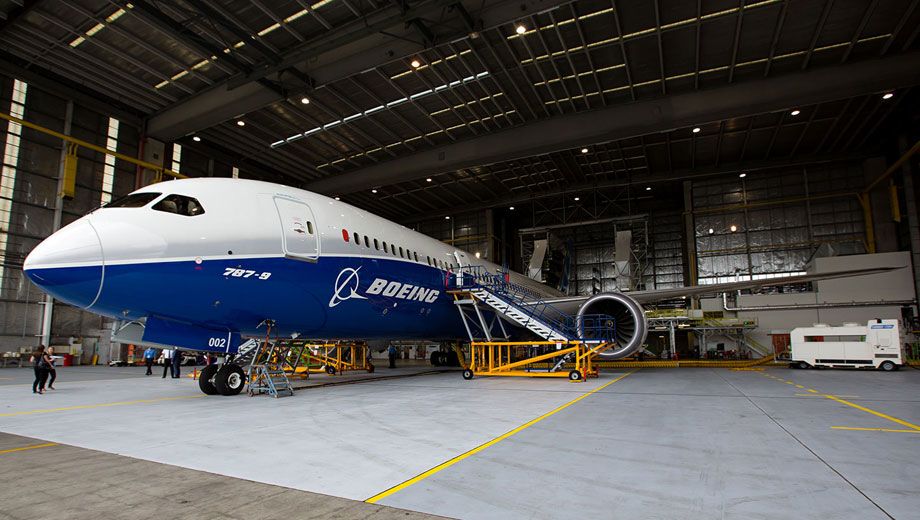Step inside Boeing’s 787-9 Dreamliner ZB002 on this exclusive tour of what is only the world’s second stretched Dreamliner before large-scale production begins ahead of its debut in July with worldwide launch customer Air New Zealand.
Long before any new commercial aircraft takes to the skies with paying passengers on board, manufacturers such as Airbus and Boeing carry out an exhaustive series of flight tests with specially-build aircraft.
The Boeing Dreamliner 787-9 which carries the ZB002 model number is part of that process for this larger, longer-range version of the original 787-8 Dreamliner.
The second of three 787-9s dedicated to the new plane’s test program, ZB002 last week flew non-stop from Seattle to Auckland – marking the 787-9’s longest flight, at just under 14 hours – and is now ZB002 visiting Alice Springs, in the centre of Australia, to undergo extensive heat testing under the sizzling summer sun.
Read: Boeing 787-9 begins heat stress tests in Australian outback
So what’s it like inside of of these special test aircraft?
Boeing invited Australian Business Traveller to tour ZB002 during its short sojourn in Auckland and we’re pleased to bring you these exclusive photos taken by our New Zealand contributor Nick Young who accompanied AusBT on the day.
If you’re already familiar with the Dreamliner via the original 787-8 series, the first thing that strikes you when you get up close to the 787-9 is that it somehow looks right.
It’s not the size per se – it’s only 6 metres (20 feet) longer than the -8, which allows room for up to 40 more seats.
It’s about the plane’s proportion, and how that extra length seems perfectly matched to the Dreamliner’s tall proud tail, sharply sculptured wings and and overall sense of scale.
Speaking of those wings, they’re still a sight.
And strapped to these wings are the two Rolls-Royce Trent 1000 engines which will drive Air New Zealand’s Dreamliner.
Engineers from Rolls-Royce are part of the hand-picked crew aboard ZB002, and among its racks of test equipment are custom-built monitoring systems to chart every aspect of the engines’ performance.
While we’re still outside the plane, note the registration number on the tail – 789 is industry shorthand for the Boeing 787-9 while FT of course stands for Flight Test.
The entry to ZB002 is the same as all other Dreamliners, at least in the ‘basic Boeing’ state without any customisation from airlines (which can include relocating the galley and dressing up the entry with a bar).
The curved ceiling panels with its carved recesses and blue LED lighting conveys that same sense of space.
More subtly, it communicates the Dreamliner’s modern design – that there’s something different about this aircraft, compared to the planes you’re used to flying in.
At this point in most planes, turning left takes you into the premium cabin of business class or even first class.
Not so in Boeing’s 787-9 test aircraft.
On ZB002, every seat is an economy seat – they’re fairly comfortable, but are undeniably intended for shorter runs around the US rather than the trek from Seattle to New Zealand and Australia.
Naturally, these will be replaced with Air New Zealand’s mix of business class, premium economy and economy seats when this aircraft is eventually refurbished and handed on to the Kiwi carrier late next year.
Photos, video: Air New Zealand's Boeing 787-9 Dreamliner seats
There’s not even any inflight entertainment: the screens and controllers you see on the back of each seat are non-working dummies, as these seats are effectively ‘factory demo’ models from one of Boeing’s approved seat suppliers for the Dreamliner.
Boeing has fitted 90 seats to this 787-9, and on the Dreamliner’s journey ‘down under’ it carried a full complement of engineers and support crew from Boeing.
You’d think that a plane conservatively designed to seat up to 300 passengers would allow plenty of legroom between the seats.
Not so: it’s not much more than a standard economy layout.
Row 1 offers a bit of extra room to stretch out, if it wasn't for that life raft.
There’s also no view, with the window being replaced by a solid panel onto which exterior test gear is mounted (you can see the equipment protruding from the first window in the space below).
Of course, the best view is from these seats…
The Dreamliner’s state of the art flight deck includes two digital ‘heads-up displays’ (HUDs) which show the most vital information while pilots can keep looking outside and ahead rather than having to continually glance down at the instruments.
Like the 787-8, the -9 also sports touchscreen ‘electronic flight bags’ which replace the reams and kilograms of paper usually carried in the cockpit.
Pilots can call up maps, charts, manuals plus special apps for common tasks as takeoff calculations, which can then be sent directly to the plane’s flight management computers.
And as with all US vehicles, there are coffee cup holders.
So much for the front of the Dreamliner.
What would happen if, on entering the plane, you turned right?
That would take you into ‘the realm of racks’ where sophisticated equipment keeps tabs on almost everything than can be measured on the Dreamliner.
On ZB002’s Australia/NZ trip particular attention will be paid to automatic landings, fuel performance, avionics (the aircraft’s electronics sub-systems) and environmental controls system.
Boeing is quite protective of this gear, so we weren’t allowed to take any photos of specific bits of kit, except for this pair of racks which help the Rolls-Royce engineers on board ZB002 keep tabs on their precious engines.
Nor would Boeing even hint at the cost of all this equipment, which is connected to data-gathering points all over the 787-9 – including the wings and engines – by a network of orange cables.
The tests build on those previously conducted for approval of the original Boeing 787-8 says Ryan Smith, Boeing's Test Operations Manager for the 787-9 program.
“Being a derivative of the -8 there are standard tests that we need to do, but because a lot of the testing we actually did previously on the -8, this is just a subset of what a major model needs to go through” Smith tells Australian Business Traveller.
In the case of the ‘heat tests’ carried out in Alice Springs this means leaving the aircraft sitting on the tarmac at Alice Springs Airport “and letting it bake under the sun until the late afternoon”, Smith explains.
"Then we will turn all the systems on and let the airplane cool off" Smith says, before taking off for a flight of "between one to two hours" to check that the aircraft and its systems perform within specification.
Temperatures in Australia’s ‘Red Centre’ this week have peaked at 33.6 degrees Celsius (92.5 degrees Fahrenheit).
That's a few degrees cooler than the 38 degrees which Boeing would like, the engineers have plenty of other tests to run, and current forecasts suggest the mercury will bust past 38 degree mark by this weekend.
Further along the 787-9 the third passenger cabin, fitted with the same seats as the forward sections.
Directly behind this is a near spotless galley.
With NB002 making mostly short runs until now it’s seen relatively little action apart from being used to store supplies.
However, the heat testing seems to have made iced tea a tipple of choice!
What's next for ZB002..?
This is the last major test phase for the 787-9 says Dominic Thacker, the 787-9’s Lead Flight Test Engineer.
“When we return to Seattle we’ll be validating all the fuel systems, it’s mainly calibration.”
“The end of the test fleet is forecast for sometime around mid-April” Thacker tells Australian Business Traveller, “although we will have some follow-on testing with this aircraft.”
Boeing’s next two 787-9 aircraft which will be fully fitted out with seats and cabins “for two separate stages of function and reliability testing” Thacker says. “This is the final validation that everything works, and we’re ready for the customer.”
That customer is of course Air New Zealand, which will take delivery of its first Boeing 787-9 in July.
A series of trans-Tasman Dreamliner flights between Auckland and Sydney, Melbourne and Brisbane around August-September will help get the AirNZ’s flight crew and ground teams up to speed with the all-new aircraft, ahead of the Boeing 787-9’s official mid-October debut flying between Auckland and Perth.
Read: Air New Zealand gears up for Boeing 787-9 Dreamliner’s debut
Australian Business Traveller travelled to Auckland as a guest of Boeing.
Follow Australian Business Traveller on Twitter: we're @AusBT

























Cathay Pacific - Asia Miles
25 Apr 2013
Total posts 542
Lovely aircraft, the ambience sure does make up for the 3-3-3 configuration.
10 Aug 2013
Total posts 29
No. No it doesn't. Nothing makes up for prolonged discomfort.
Virgin Australia
16 Feb 2013
Total posts 16
Putting a coffee holder, fantasic, but need a double there really for water and coffee, to save the airlines tens of thousands of electronics shorting out from coffee spills.
The amount of devices I used to fix with coffee spills as their main fault... loads. Placement is great, just think it should be a double holder for a bottle of water also (and maybe a pouch for their mobile or ipad hehe)
Hi Guest, join in the discussion on Photos: Inside Boeing's 787-9 test aircraft